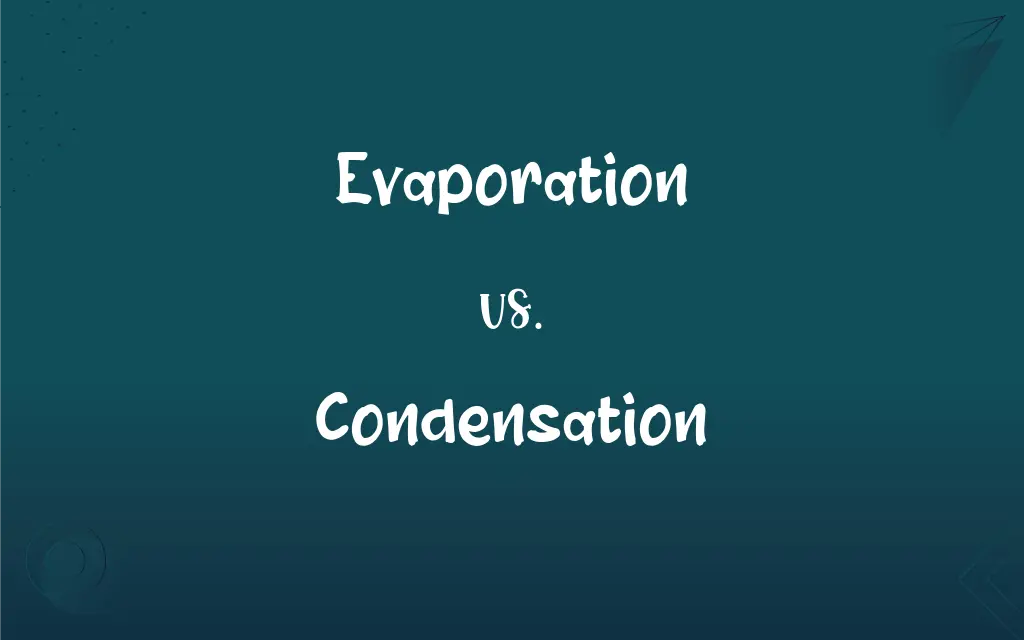Evaporation vs. Condensation: What's the Difference?
Edited by Janet White || By Harlon Moss || Updated on October 14, 2023
Evaporation is the process where liquid turns into vapor; condensation is where vapor turns back into liquid.

Key Differences
Evaporation is a natural phenomenon that occurs when a liquid, like water, is transformed into its gaseous form or vapor. On the other hand, condensation is the opposite process, where the vapor cools down and changes back into its liquid state.
While evaporation typically happens on the surface of liquids and is influenced by temperature and air pressure, condensation takes place when humid air cools down, causing the vapor to revert to liquid form, often observed as dew or water droplets.
The energy from the sun facilitates evaporation, causing water bodies like lakes and oceans to release water vapor into the atmosphere. Contrastingly, condensation becomes evident in everyday scenarios, such as when a cold beverage "sweats" in a warm environment.
In the water cycle, evaporation plays a crucial role in transporting water from the Earth's surface to the atmosphere. Conversely, condensation is responsible for the formation of clouds, which eventually lead to precipitation and return water to the Earth.
Both evaporation and condensation are essential processes for regulating the Earth's climate. While evaporation helps dissipate heat, condensation releases heat, maintaining a balance in the atmosphere.
ADVERTISEMENT
Comparison Chart
Process Direction
Liquid to gas/vapor.
Gas/vapor to liquid.
Energy Requirement
Requires energy (endothermic).
Releases energy (exothermic).
Observable Effect
Surface of liquid drying up.
Formation of water droplets on a cooler surface.
Role in Water Cycle
Transports water from Earth to atmosphere.
Helps in cloud formation & returns water to Earth.
Everyday Example
Water disappearing from a puddle.
Dew forming on grass in the morning.
ADVERTISEMENT
Evaporation and Condensation Definitions
Evaporation
The process by which surface liquid is converted to vapor.
Evaporation of sweat helps in cooling our bodies.
Condensation
The transformation of a gaseous substance into its liquid state.
Cold mornings often show the effects of condensation on windows.
Evaporation
A phase transition from a liquid state to a vapor state.
High temperatures expedite the evaporation rate of moisture.
Condensation
The process where vapor becomes liquid.
The cool glass caused the condensation of the humid air around it.
Evaporation
The transformation of a liquid into its gaseous form.
The evaporation of the lake water increased during the hot summer months.
Condensation
The change from a vapor phase to a liquid phase.
The condensation of steam can produce pure distilled water.
Evaporation
The release of molecules from the surface of a liquid into the air.
The rapid evaporation of the solvent left behind a crystalline residue.
Condensation
The act of making more dense or compact.
The condensation of the gas resulted in a liquid form at the bottom of the container.
Evaporation
The dissipation of a liquid when exposed to air.
The evaporation of spilled water on the pavement was quick under the midday sun.
Condensation
The formation of water droplets from saturated air.
Condensation on the pitcher indicated the presence of a cold beverage inside.
Evaporation
To convert or change into a vapor.
Condensation
The act of condensing.
Evaporation
To draw off in the form of vapor.
Condensation
The state of being condensed.
FAQs
Can condensation occur without evaporation?
No, condensation is the reverse process of evaporation.
Is energy released or absorbed during evaporation?
Energy is absorbed during evaporation.
Is dew a result of condensation?
Yes, dew forms when humid air condenses on cool surfaces.
Why do we see condensation on cold drinks?
Warm air around the cold drink cools down, leading to condensation.
What triggers evaporation?
Evaporation is triggered by heat or energy.
How is condensation linked to the water cycle?
Condensation forms clouds, a vital step in the water cycle.
What's the main difference between evaporation and condensation?
Evaporation turns liquid to vapor, while condensation turns vapor back to liquid.
How is evaporation used in daily life?
Evaporation is used in processes like drying clothes, distillation, and cooking.
How is evaporation related to boiling?
Both involve turning liquid into vapor, but boiling occurs throughout a liquid at a specific temperature.
How does condensation lead to rain?
Condensation in the atmosphere forms clouds, which can result in precipitation.
Can evaporation occur at any temperature?
Yes, evaporation can occur at any temperature, but it's faster at higher temperatures.
Why does condensation form on windows?
Warm, moist indoor air cools upon contact with cold windows, leading to condensation.
Is the energy required for evaporation and condensation the same?
The energy absorbed in evaporation is the same as that released during condensation.
When does condensation commonly happen?
Condensation often occurs when warm, humid air meets a cold surface.
Can condensation be prevented?
Reducing humidity or maintaining temperature can reduce condensation.
Does wind speed affect evaporation?
Yes, higher wind speeds can increase the rate of evaporation.
How does evaporation cause cooling?
Evaporation absorbs heat, leading to a cooling effect.
Does evaporation only happen in open areas?
No, evaporation can occur even in closed systems, though at a reduced rate.
Is evaporation a slow or fast process?
Generally, evaporation is a slow process, but it can be faster with added heat.
Can condensation occur in the air?
Yes, when moist air cools, condensation can occur, forming clouds or fog.
About Author
Written by
Harlon MossHarlon is a seasoned quality moderator and accomplished content writer for Difference Wiki. An alumnus of the prestigious University of California, he earned his degree in Computer Science. Leveraging his academic background, Harlon brings a meticulous and informed perspective to his work, ensuring content accuracy and excellence.
Edited by
Janet WhiteJanet White has been an esteemed writer and blogger for Difference Wiki. Holding a Master's degree in Science and Medical Journalism from the prestigious Boston University, she has consistently demonstrated her expertise and passion for her field. When she's not immersed in her work, Janet relishes her time exercising, delving into a good book, and cherishing moments with friends and family.































































